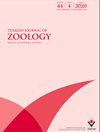台湾赫曼龟的种群遗传结构
IF 1.3
4区 生物学
Q2 ZOOLOGY
引用次数: 0
摘要
保护濒危物种的多学科方法在制定管理计划方面具有重要意义。除了生态和种群统计参数外,遗传数据还为物种保护管理计划提供了重要信息。赫尔曼陆龟(Testudo hermanni)遭受非法贸易、火灾、栖息地破碎和破坏,因此,区域种群的遗传多样性受到影响。该物种被国际自然保护联盟(iucn)列为近危亚种,在欧洲大陆的分布有限。对来自斯里兰卡色雷斯地区15个不同地点的221只象龟的15个微卫星位点进行了研究。所有基因座均呈多态性,等位基因数量在2 ~ 13个之间。各地点的私有等位基因数量(Pa)在0 ~ 6之间。平均基因多样性为0.31(范围为0.25 ~ 0.38)。等位基因丰富度、私有等位基因丰富度和遗传多样性(Ar、Pa、He)在3号和7号位点均达到最高水平。总体(p < 0.001)和15个研究地点中的12个偏离Hardy-Weinberg平衡。在研究的15个地点中,6个地点的近交系数差异显著。此外,两阶段突变模型(TPM) (p < 0.001)检测到种群中最近的瓶颈。群体遗传结果显示,在2个大聚类(K = 2)中,8个群体遗传结构显著(F$_{ST}$ = 0.166, p < 0.01)。本文章由计算机程序翻译,如有差异,请以英文原文为准。
Population Genetic Structure of Testudo hermanni boettgeri (Hermann's Tortoise) in Türkiye
Multidisciplinary approaches for the conservation of endangered species have great importance in preparing management plans. In addition to ecological and population demographic parameters, genetic data provide vital information for conservation management plans for a species. The Hermann's tortoise (Testudo hermanni) suffers from illegal trade, fires, habitat fragmentation and destruction, and therefore, the genetic diversity of the regional populations has been affected. It was aimed herein to impart knowledge on the population genetic structure of T. hermanni boettgeri, listed as near threatened by the International Union for Conservation of Nature Red List as a subspecies and has limited distribution in European Türkiye. A study was conducted of 15 microsatellite loci of 221 tortoises from 15 different localities in the Thrace region in Türkiye. All of the examined loci were polymorphic, and the number of alleles varied from 2 to 13. The quantity of private alleles (Pa) at the localities ranged from 0 to 6. The average gene diversity was 0.31 (range: 0.25-0.38). The highest levels of allelic richness, private alleles, and genetic diversity (Ar, Pa, He) were observed at localities 3 and 7, close to each other. The total population (p < 0.001) and 12 of the 15 studied localities diverged from the Hardy-Weinberg equilibrium. Of the 15 localities studied, 6 had significantly different inbreeding coefficients. Furthermore, a 2-phased model of mutation (TPM) (p < 0.001) detected a recent bottleneck in the population. The population genetic results identified 8 groups with significant genetic structure (F$_{ST}$ = 0.166, p < 0.01) in 2 large clusters (K = 2).
求助全文
通过发布文献求助,成功后即可免费获取论文全文。
去求助
来源期刊

Turkish Journal of Zoology
ZOOLOGY-
CiteScore
2.30
自引率
10.00%
发文量
24
审稿时长
6-12 weeks
期刊介绍:
The Turkish Journal of Zoology is published electronically 6 times a year by the Scientific and Technological Research Council of Turkey (TÜBİTAK).
-Accepts English-language manuscripts in various fields of zoology including systematics, developmental biology, behaviour biology, animal models, molecular biology and molecular phylogeny, genomics, physiology (cell communication and signaling systems), biochemistry and immunohistochemistry, applied parasitology and pathology, nanobiotechnology, ecology, evolution, and paleontology of animal taxa.
-Contribution is open to researchers of all nationalities.
-Short communications are also welcome, such as reports of a preliminary nature or those including new records from specific localities or regions, and the editor reserves the right to decide that a paper be treated as a short communication.
-The papers that deal with purely checklists, new host and non-regional new locality records will not be consider for publication.
-Letters to the editor reflect the opinions of other researchers on the articles published in the journal. The editor may also invite review articles concerning recent developments in particular areas of interest.
 求助内容:
求助内容: 应助结果提醒方式:
应助结果提醒方式:


